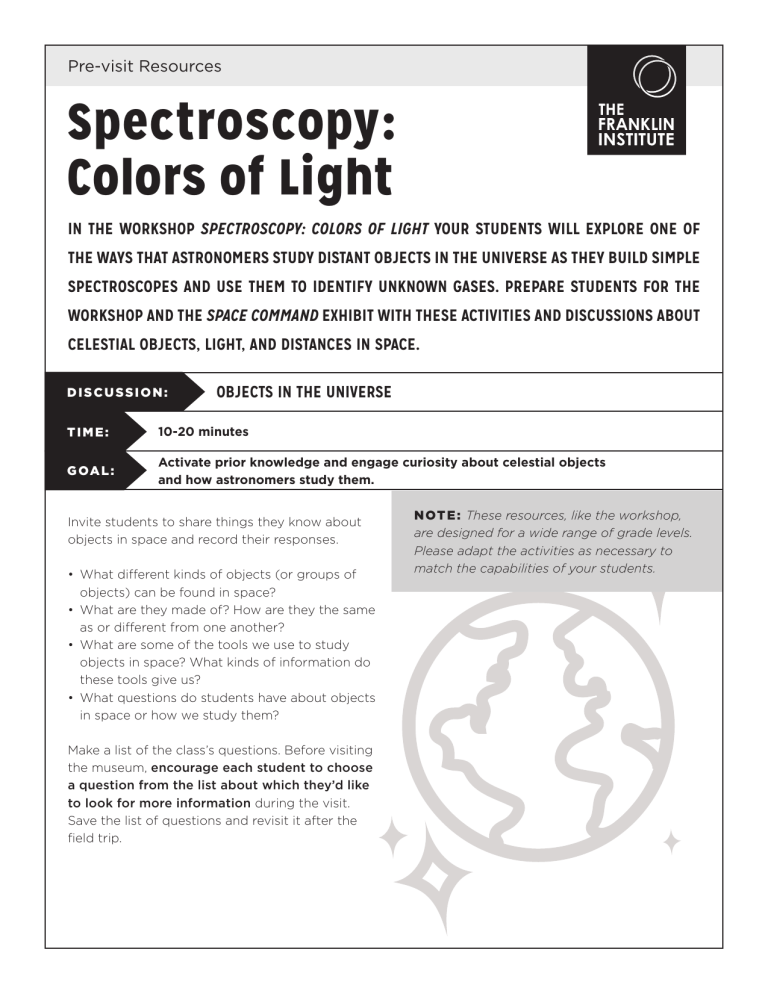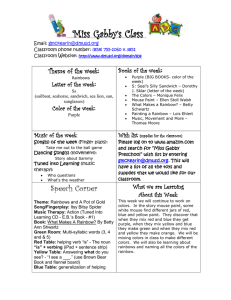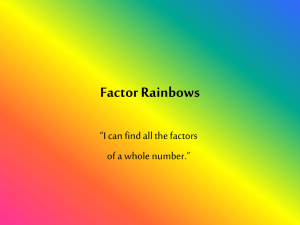Spectroscopy: Colors of Light

Pre-visit Resources
Spectroscopy:
Colors of Light
IN THE WORKSHOP SPECTROSCOPY: COLORS OF LIGHT YOUR STUDENTS WILL EXPLORE ONE OF
THE WAYS THAT ASTRONOMERS STUDY DISTANT OBJECTS IN THE UNIVERSE AS THEY BUILD SIMPLE
SPECTROSCOPES AND USE THEM TO IDENTIFY UNKNOWN GASES. PREPARE STUDENTS FOR THE
WORKSHOP AND THE SPACE COMMAND EXHIBIT WITH THESE ACTIVITIES AND DISCUSSIONS ABOUT
CELESTIAL OBJECTS, LIGHT, AND DISTANCES IN SPACE.
D I S C U S S I O N :
OBJECTS IN THE UNIVERSE
T I M E :
G OA L :
10-20 minutes
Activate prior knowledge and engage curiosity about celestial objects and how astronomers study them.
Invite students to share things they know about objects in space and record their responses.
• What different kinds of objects (or groups of objects) can be found in space?
• What are they made of? How are they the same as or different from one another?
• What are some of the tools we use to study objects in space? What kinds of information do these tools give us?
• What questions do students have about objects in space or how we study them?
Make a list of the class’s questions. Before visiting the museum, encourage each student to choose a question from the list about which they’d like to look for more information during the visit.
Save the list of questions and revisit it after the field trip.
N OT E : These resources, like the workshop, are designed for a wide range of grade levels.
Please adapt the activities as necessary to match the capabilities of your students.
Pre-visit Resources
Spectroscopy: Colors of Light
AC T I V I T Y:
T I M E
SOLAR SYSTEM ON A ROLL
(Adapted from an activity by the Astronomical Society of the Pacific: www.astrosociety.org/edu/family/materials/toiletpaper.pdf )
30-45 minutes
G OA L : Create a scale model illustrating distances between objects in the solar system.
M AT E R I A L S :
• Matchbox car, globe, or other model of a larger object (optional)
• Toilet paper, 1 full roll per group
• Felt tip markers, preferably in 10 different colors
• Clear tape for repairs
• A long hallway or other large space
(at least 45 feet long)
• Meter sticks or metric tape measures
• Calculators (optional)
P R O C E D U R E :
1. Introduce the activity with a discussion of distances in space. How do we measure distances on Earth? In space? What are some ways we might study or think about things that are very large or far away?
2. Use the matchbox car or globe to demonstrate the idea of a scale model. How is the matchbox car similar to a real car? How is it different?
What could you learn about a real car by looking at a matchbox car? Explain that students will be making a scale model to show distances between the planets in our Solar System.
3. Divide students into small groups and provide each with markers, a roll of toilet paper, and the following instructions:
• Tear one piece of toilet paper from the roll and use as a test sheet for the markers.
Practice writing gently on the toilet paper.
• Make a dot on the seam between the first and second sheets of toilet paper. Label this dot “Sun”.
• Using the table below, mark the distances to each object as you unroll the paper. The number in the table is the number of toilet paper sheets needed to reach the object’s orbit from the sun, so keep a running count as you go.
• Make a dot and write the object’s name at each distance indicated, using a different color for each object and making repairs with tape as necessary.
Pre-visit Resources
Spectroscopy: Colors of Light
AC T I V I T Y:
SOLAR SYSTEM ON A ROLL
P L A N E T
Mercury
Venus
Earth
Mars
Asteroid Belt
Jupiter
Saturn
Uranus
Neptune
Kuiper Belt (incl. Pluto)
D I STA N C E
F R O M S U N
(toilet paper squares)
1.0
1.8
2.5
3.8
7.0
13.2
24.2
48.6
76.3
100.0
AC T UA L D I STA N C E F R O M S U N
57,910,000 km / 35,983,606 mi
108,200,000 km / 67,232,363 mi
149,600,000 km / 92,957,130 mi
227,940,000 km / 141,635,350 mi
414,436,363 km / 257,518,817 mi
778,330,000 km / 483,631,840 mi
1,429,400,000 km / 888,187,982 mi
2,870,990,000 km / 1,783,950,479 mi
4,504,000,000 km / 2,798,655,850 mi
5,913,520,000 km / 3,674,490,973 mi
4. Bring completed models to a long hallway or outdoor space and carefully unroll them.
What do students notice about the distances between objects in our solar system?
5. Use meter sticks or tape measures to measure the distance in meters from the sun to the
Kuiper Belt in this model.
6. Alpha Centauri, the nearest star to our solar system, is 4.2 light years away. This is approximately 10,000 times further from the sun than the Kuiper Belt. Ask students to calculate the following:
• How many squares of toilet paper would be needed to add Alpha Centauri to their models?
• If an average roll of toilet paper has 300 sheets, how many rolls of toilet paper would that be?
• Based on their measurements of their models, how many meters (or kilometers) away would the end of the toilet paper model be, if it included Alpha Centauri?
7. Where would their toilet paper models end if they included Alpha Centauri? Challenge students to consult a map and find a landmark that is as far from your school as Alpha Centauri is from the sun in the toilet paper model.
Pre-visit Resources
Spectroscopy: Colors of Light
AC T I V I T Y:
SOLAR SYSTEM ON A ROLL
N OT E S :
• In this activity, only the relative distances between the objects in the solar system are represented (not the relative sizes of the objects). At this scale, the sun would be roughly the size of an apple seed, Jupiter would be the size of a grain of salt, and
Earth would be too tiny to see.
• The orbits of the planets are elliptical rather than circular, so the distances listed are average distances from the sun. Also, the planets will never be aligned in a perfectly straight line as they are shown in this model—they are always in different parts of their orbits.
• The toilet paper model of the solar system will be approximately 14 meters long. Adding
Alpha Centauri would make it approximately
140 km (87 mi) long.
R E F L E C T I O N :
• What did students notice or learn about the solar system from this model?
• In what ways is this model similar to the actual solar system, and in what ways is it different?
E X T E N S I O N S :
• For a hands-on experience that models the relative sizes of objects in space, see the following activity: http://wise.ssl.berkeley.edu/ documents/scalerealmsuniverse.pdf
• An online Scale of the Universe interactive
(http://htwins.net/scale2/ ) allows students to zoom in and out of various orders of magnitude and explore the relative sizes of objects in the universe. The video version could also be used as an introduction or demonstration: (https:// www.youtube.com/watch?v=uaGEjrADGPA)
• What things about the solar system does this model not show? What kinds of models might do a better job of illustrating them?
Pre-visit Resources
Spectroscopy: Colors of Light
I N V E ST I G AT I O N :
T I M E
WHAT MAKES A RAINBOW?
Three 15–20-minute investigations, plus time for introduction and discussion
G OA L Investigate the separation and combination of different colors (wavelengths) of visible light.
M AT E R I A L S :
Part 1 – Prisms
• Room that can be darkened
• Bright incandescent light sources (flashlight, clip-on lamp, etc.), 1 per station. Clear bulbs, not white/frosted, work best.
• Pieces of cardboard or cardstock with a
2–3”-long slit cut in each, 1 per station
• Prisms, at least 1 per station
• White paper and a way to hold it vertically, such as taping it to the side of a box
• Pencils
Part 2 – Filters
• Materials from Part 1
• Red, green, and blue filters, 1 each per station. The acetate “gel” filters used in stage lighting work best, but colored cellophane could be substituted. If using cellophane, test in advance—multiple layers may be needed for a strong color change.
Part 3 – Light Sources
• Materials from Part 1
• Light source with fluorescent bulb
• Light sources with other varieties of bulbs, such as:
• Halogen or LED
• Different wattages of incandescent bulb
• Different shades of bulb—soft white, daylight, clear, etc.—and/or colored bulbs
P R O C E D U R E :
1. The three parts of this investigation could be done by the whole class in sequence, set up as rotating stations, or used individually.
Each group or station needs a set-up that allows a light source to shine through a slit in the cardboard onto a vertical white surface.
The websites listed at the end of this activity provide various suggestions for ways to do this.
2. Introduce the activity by asking students what they know about rainbows. Where have they seen them? What things do you need to make a rainbow? Where do the colors come from?
Record their responses and hypotheses and explain that they will be conducting some investigations to find out more information about how rainbows form.
3. Demonstrate how to set up the light source, slit, and white paper, if not already in place.
Darken the room.
4. Ask students to shine the light through the slit and observe what happens.
5. Give each group a prism and challenge them to figure out how to use it to make a rainbow. Where does the prism have to be?
In which orientation or direction must it face?
Encourage groups to share information so that all groups can successfully create a rainbow on the white paper before continuing.
Pre-visit Resources
Spectroscopy: Colors of Light
I N V E ST I G AT I O N :
WHAT MAKES A RAINBOW?
Part 1—Prisms
6. Ask groups to remove the prism and trace on the paper where the light from the slit falls, then replace the prism and compare the rainbow to the traced outline.
• Is the rainbow in the same place as the original light?
• Is it the same size? The same shape?
• Is it similar or different in any other ways?
9. Encourage groups to try the green and blue filters and observe the results; then try combinations of two filters.
• What color is the light on the paper? What happens when the prism is added?
• How do the “rainbows” change with each filter or combination of filters?
• What happens if all three filters are used?
7. Encourage students to try moving the prism, paper, and/or slit and notice any changes in the light on the paper.
• What happens if the prism is closer to the slit? Closer to the paper?
• What happens if the paper and the slit are close together? Far apart?
• Which arrangement makes the biggest rainbow? Which makes the brightest?
• What role does the cardboard with the slit play? What happens without it?
10. Remind students to record their observations and conclusions.
Part 3—Light Sources
11. Ask students to replace the original light source with a compact fluorescent and observe the resulting rainbow. How is it the same? How is it different?
12. Invite groups to explore the rainbows created by other types of light bulbs.
• Which bulbs create similar rainbows? What differences are there between the rainbows made by different types of bulbs?
Part 2—Filters
8. Invite students to place the red filter in front of the light source.
• What color is the light on the paper
(without the prism)? What happens when the prism is added?
Pre-visit Resources
Spectroscopy: Colors of Light
I N V E ST I G AT I O N :
WHAT MAKES A RAINBOW?
R E F L E C T I O N :
Review the ideas and hypotheses the students made at the beginning of the activity and compare to the results of their investigations.
• What did you find out about how prisms create rainbows?
• What did you find out about changing the color of the light making the rainbow?
• How does the type of light bulb affect the rainbow?
• Based on your investigations, what can you say about how rainbows are made? What do you think the prism does? Where do you think the colors come from?
• What questions do you still have? How could you find out more about those questions?
with a combination of prism, colored filter, and/ or bulb, and the other partner (or the class) tries to determine what the set-up is, based on the light they see on the paper. What clues help to identify the set-up? What tells you if there is a prism? A filter?
Sir Isaac Newton was the first to demonstrate that white light is made up of all the colors of the spectrum. Ask students to research
Newton’s original experiment —what question was he trying to answer? How did he set up his experiment? Challenge them to recreate his experiment and see if they can confirm his results.
E X T E N S I O N S :
Encourage students to conduct a second investigation into one of the questions generated by the group discussion.
Other possibilities could include:
• What other objects create rainbows? (What type of substance? What shape or thickness?)
• What happens with more than one prism?
• What happens to the rainbow if the colored filters are combined with the other types of light bulb?
Identification Challenge —Astronomers use the light coming from distant stars to provide clues about the stars themselves. Try a similar task with the elements from this experiment. Arrange the experimental set-up so that a person (or the class) can view the light projected on the paper without seeing the prism, slit, or filter.
One person (or the teacher) creates a rainbow
S E T- U P I D E A S A N D
R E L AT E D AC T I V I T I E S :
Exploring Light and Prisms: https://cms.bsu.edu/-/media/WWW/
DepartmentalContent/FSEEC/docs/
Exploring%20Light%20and%20Prisms.doc
Spectroscopy Activity: http://www.teachengineering.org/view_activity.
php?url=collection/cub_/activities/cub_spect/ cub_spect_activity7.xml
Two Prisms, Four Demos: http://blog.teachersource.com/2011/11/26/twoprisms-four-demos/


